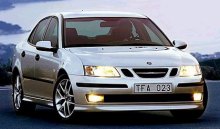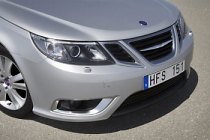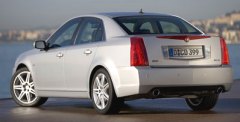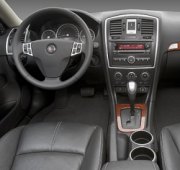|
Saab 9-3
Debut: 2002
Maker: Saab
Predecessor: 9-3 Mk1
|
|
 Saab,
a small Swedish car maker, always sells by its uniqueness. Special
shape,
special cockpit and turbocharged 4-pot engines are the trademarks of
Saab.
Even though it is under the umbrella of GM, Saab knows its survival
depends
very much on its unique character. Saab,
a small Swedish car maker, always sells by its uniqueness. Special
shape,
special cockpit and turbocharged 4-pot engines are the trademarks of
Saab.
Even though it is under the umbrella of GM, Saab knows its survival
depends
very much on its unique character.
 From
the new 9-3, you can still see the pursuit of unique character.
Although
the exterior shape becomes more mainstream (I’m afraid the "ugly equals
to unique" theory of Saab 900 can no longer work today), once you enter
the cockpit you can easily recognize it as a Saab. The
jet-fighter-style
dashboard and console remains in the tradition of Saab. The Swedish
also
distinguish themselves from German rivals by placing ergonomics in
first
place. To prevent from distracting driver's sight from the road, Saab
positions
the display of trip computer at the bottom edge of windscreen and
mounts
the most frequently used controls high at the dashboard. From
the new 9-3, you can still see the pursuit of unique character.
Although
the exterior shape becomes more mainstream (I’m afraid the "ugly equals
to unique" theory of Saab 900 can no longer work today), once you enter
the cockpit you can easily recognize it as a Saab. The
jet-fighter-style
dashboard and console remains in the tradition of Saab. The Swedish
also
distinguish themselves from German rivals by placing ergonomics in
first
place. To prevent from distracting driver's sight from the road, Saab
positions
the display of trip computer at the bottom edge of windscreen and
mounts
the most frequently used controls high at the dashboard.
Although
9-3 is neither the biggest nor the best built junior executive car, its
cockpit is what a good place to be in. The rear seats offer good leg
and
headroom. Driving position is superbly ergonomical, thanks to endless
adjustment
and the high dashboard. Seats are superbly comfortable. The visual
quality
of plastic and trimming is pretty good. With dark leather and "Vector"
alloy-effect trimming, the cabin delivers a sense of luxury in the same
way as Swedish furniture.
 Like
its predecessor, the new 9-3 shares platform with Opel Vectra. GM calls
this global platform as Epsilon, which will also give birth to the next
Saturn L-series, Chevrolet Malibu, Pontiac Grand Am and Opel Signum.
Compare
with the old platform, Epsilon is much more sophisticated and by no
means
a cheap design. First of all, it has a very rigid chassis, with a
torsional
rigidity of 20,000Nm/degree, even surpassing the already remarkable
Vectra.
A hydroformed subframe is employed to mount the engine and suspensions,
improving chassis strength while reducing NVH. The Epsilon also has
good
suspensions, with MacPherson struts up front and multi-link at the
rear.
This compare favourably with the semi-trailing arm setup of the old
9-3.
Moreover, the rear suspensions are also mounted on subframe to reduce
noise
and harshness. Like
its predecessor, the new 9-3 shares platform with Opel Vectra. GM calls
this global platform as Epsilon, which will also give birth to the next
Saturn L-series, Chevrolet Malibu, Pontiac Grand Am and Opel Signum.
Compare
with the old platform, Epsilon is much more sophisticated and by no
means
a cheap design. First of all, it has a very rigid chassis, with a
torsional
rigidity of 20,000Nm/degree, even surpassing the already remarkable
Vectra.
A hydroformed subframe is employed to mount the engine and suspensions,
improving chassis strength while reducing NVH. The Epsilon also has
good
suspensions, with MacPherson struts up front and multi-link at the
rear.
This compare favourably with the semi-trailing arm setup of the old
9-3.
Moreover, the rear suspensions are also mounted on subframe to reduce
noise
and harshness.
Saab
emphasis that it took part in the development of Epsilon from the very
beginning, therefore the 9-3 chassis is tailor-made rather than adapted
from Vectra’s. In fact, the 9-3 is longer, narrower and whose wheelbase
is 25mm shorter than the Vectra. Its steering employs conventional
hydraulic
assistance instead of the electro-hydraulic type of the Vectra as an
attempt
to improve steering feel. Its suspensions are tuned to be stiff
laterally
and soft vertically, this should improves motorway ride while ensuring
good handling in twisty roads.
On
motorways, the 9-3 is really superbly comfortable - it rides smoothly
and
quietly, so refined that it could be the best choice for long-distance
travel alongside Mercedes C-class. Its steering display similar refined
manner - well-weighted, precise and free of vibration. It also
communicates
better with the driver than Vectra, though not good enough to trouble
BMW,
Audi, Jaguar and Mercedes.
Push
harder, the 9-3 still displays well-mannered handling. It handles much
better than the old 9-3 Viggen. Admittedly, this is a pointless
comparison,
because the Viggen was one of the worst cars AutoZine ever rated (just
1 star when it was new). In fact, the new 9-3 has completely solved the
fierce torque steer and wheelspin problems troubling its predecessor.
The
stronger chassis, the better suspensions and the cleverer Trionic 8
engine
management system enable power put down on the ground effectively via
the
front wheels. Trionic 8, now runs on a 32-bit computer, automatically
smoothens
power output at sudden throttle opening to prevent from too much power
upsetting the chassis. Even in the 210hp Aero model, handling remains
smooth
and tidy.
However,
it would be very wrong to assume the new 9-3 matches its
rear-wheel-drive
and 4-wheel-drive rivals in handling. If you push it too hard, it won't
display the same level of body control and mid-corner adjustability as
its rivals. That said, Saab 9-3 is good to drive, but not designed for
the most demanding drivers.
 However,
if we take the engine into account, the new 9-3 makes a lot of sense to
keen drivers. Given a limited budget, your best choice of junior
executive
car could be either an entry-level BMW 318i, an Audi A4 1.8T or Saab
9-3
2.0t with 175 horsepower. The Saab is not only more powerful, faster in
straight line and stronger in overtaking, but also delivers its power
in
an extremely refined manner. Light-pressure turbine ensures lag-free
throttle
response and a smooth power curve. Twin-balancer shafts and rigid
engine
construction suppress vibration and noise effectively. No other
turbocharged
inline-4 engines in the world could match its refinement, Audi's
included. However,
if we take the engine into account, the new 9-3 makes a lot of sense to
keen drivers. Given a limited budget, your best choice of junior
executive
car could be either an entry-level BMW 318i, an Audi A4 1.8T or Saab
9-3
2.0t with 175 horsepower. The Saab is not only more powerful, faster in
straight line and stronger in overtaking, but also delivers its power
in
an extremely refined manner. Light-pressure turbine ensures lag-free
throttle
response and a smooth power curve. Twin-balancer shafts and rigid
engine
construction suppress vibration and noise effectively. No other
turbocharged
inline-4 engines in the world could match its refinement, Audi's
included.
If
you remember, Saab is always the expert of turbocharged inline-4
engines.
As early as 1985 it was already mass-producing a 2-litre four with
twin-cam
16 valves, twin-balancer shafts, turbocharger and intercooler. This
family
of engines evolved and continued serving all Saab cars, excluding a
small
portion of 9-5 V6, until today.
However,
what you see in the new 9-3 is a new generation engine. It is based on
GM's L850 global four-cylinder family (see various Opel). Still employs
twin-cam 16 valves, twin-balancer shafts, turbocharger and intercooler,
the main improvement is the rigid yet lightweight all-aluminum
construction.
No wonder it is so free of NVH. So far, the Lotus-developed L850 has
been
appeared in normally aspirated form only. Saab's engineers are the
first
to turbocharge it. This requires a new cylinder head, a Garrett
turbocharger,
an intercooler and the aforementioned, very advanced Trionic 8
management
system. In entry-level form, the turbocharger runs at a boost pressure
as low as 0.5 bar. This give a modest 150hp output but a useful 178
lbft
of torque. To join BMW and Mercedes' confusing badging policy, Saab
calls
this engine as 1.8t despite of its actual capacity of 1998c.c.
2.0t
represents the same engine runs at 0.7 bar boost pressure. This give it
175hp and 195lbft. In many respect, the 2.0t is the choice of the
range.
It can top 136mph and accelerate from rest to 60mph in 8 seconds flat.
Apart from decisively stronger performance, you can hardly tell the
difference
between it and the 1.8t. In other words, same smoothness and refinement.
On
the top of the range is Aero. Again, it uses the same 2-litre engine
but
a more powerful Mitsubishi turbocharger enables maximum boost of 0.85
bar,
hence outputting 210hp and 221lbft. The Aero also gets 6-speed manual
gearbox
and stiffer suspension setup, though poorer ride quality and suspension
noise do not match the refined character of the car. However, I do love
its sportier look with extra spoilers and skirts.
Now
the junior executive car segment is added with another strong
competitor.
Whether you choose it over BMW, Audi, Jaguar and Mercedes depends on
whether
you love the unique character of Saab. The 9-3 is clever to distinguish
itself from rivals. Powered by the world’s best turbocharged four,
having
a comfortable and ergonomic cabin, and a ride quality so refined, the
new
Saab 9-3 seems to be a sensible choice, if not an emotional one.
|
| The
above report was last updated on 9 Aug 2002. All
Rights Reserved. |
9-3 Sport Hatch and 2.8
V6 turbo
|
 As
GM announced it will shift production of the next generation 9-3 and
9-5 to Opel's factory in Germany, Saab - being a Swedish car maker - is
effectively sentenced to death. But the execution is scheduled in 2008,
so there are still 3 years to hang on. It's time to give the
3-years-old 9-3 a refresh to boost its slightly cooled down sales. As
GM announced it will shift production of the next generation 9-3 and
9-5 to Opel's factory in Germany, Saab - being a Swedish car maker - is
effectively sentenced to death. But the execution is scheduled in 2008,
so there are still 3 years to hang on. It's time to give the
3-years-old 9-3 a refresh to boost its slightly cooled down sales.
The first new element is an estate version called Sport Hatch (or
SportWagon for some countries). As implied by its name, this car does
not emphasis the capability of carrying load, but a sportier look and
driving character, just like BMW 3-Series Touring, Audi A4 Avant and
Alfa 156 Sportwagon - different names, the same thing. Its edge-cutting
rear end styling and the "ice block" taillights look rather cool. It
was the work of Michael Mauer who jumped ship to Porsche last year.
The luggage carrying capacity is average by class standard. When the
rear seat is in normal position, its luggage capacity measures 419
litres (BMW: 460; Audi: 442; Alfa: 360). Fold the rear seat and the
load capacity increases to 1273 litres (BMW: 1380; Audi 1184; Alfa:
1180). That means if you want driving excitement and practicality
simultaneously, go to the BMW camp instead.
Another new addition to the 9-3 is a 2.8-litre turbocharged V6. It is
derived from the Holden V6, produced in Australia but Saab involved the
development of the turbocharging system, which is unique to Saab. The
normally aspirated version of the 2.8-litre all-aluminum 60-degree
engine has been used in Cadillac CTS. Based on that engine, Saab added
a Mitsubishi turbocharger running at a light boost pressure of 0.6 bar.
Because only a single turbo is employed, it chose a twin-scroll
turbocharger which separate the exhaust gas from the two banks of
cylinders to avoid interference. Other changes to the engine include a
lower, 9.5:1 compression, sodium-filled exhaust valves (for better heat
dissipation to deal with the extra heat generated by high pressure),
stronger forged steel crankshaft and sintered forged con-rods. The flat
torque characteristic of turbocharging allows the discard of
variable-length intake manifolds, but intake variable valve timing is
retained.
 Installed
in the 9-3 Aero, the engine produces 250 horsepower at 5500 rpm and 258
lbft of torque from 2000 to 4500 rpm. By the standard of light-pressure
turbocharging, its power output cannot be described as disappointing,
especially its emphasis is on easily accessible torque, i.e., some 90%
of the maximum torque is available from just 1500 rpm. Performance is
pretty strong too - acceleration from rest to 60 mph takes only 6.6
seconds for the sedan and 6.9 seconds for the estate. Top speed is 155
mph and 152 mph respectively. Installed
in the 9-3 Aero, the engine produces 250 horsepower at 5500 rpm and 258
lbft of torque from 2000 to 4500 rpm. By the standard of light-pressure
turbocharging, its power output cannot be described as disappointing,
especially its emphasis is on easily accessible torque, i.e., some 90%
of the maximum torque is available from just 1500 rpm. Performance is
pretty strong too - acceleration from rest to 60 mph takes only 6.6
seconds for the sedan and 6.9 seconds for the estate. Top speed is 155
mph and 152 mph respectively.
Nevertheless, the engine is not very inspiring. Because of its
low-revving manner and flat torque curve, keen drivers will find it not
very interesting to exploit. Although its power delivery is lag-free,
its not as smooth-revving as expected, showing no significant advantage
over the existing 2.0 turbo, balance-shaft-equipped four-pot.
Saab used to be famous of building very good 4-cylinder turbocharged
engines. By switching to GM's new V6, its unique character continues to
fade out. Now we are worrying about the forthcoming Alfa 159, which
uses the 3.2-litre version of the same V6.
The new 9-3 Aero is fast but not very exciting to drive. Apart from the
soulless engine, torque steer is also more pronounced than before,
blame to the stronger torque transmitted to the front wheels. Sadly,
the outgoing 210hp Aero was actually a better drive.
|
| The
above report was last updated on 4 Jun 2005. All
Rights Reserved. |
9-3 facelift 2007
|
After 5 long years, Saab
9-3 has
received a mid-life boost finally. Thankfully, the changes are quite
extensive. Outside, the car gets a more beautiful front end including a
new bumper, a more prominent corporate grille, wrap-around headlights
and 9-5-style clamshell bonnet. The facelift changed some 70 percent of
the body panels and you can see the differences clearly. I would say it
is a successful facelift.
In the mechanical side, there are 3 improved engines:
- 1.9TTiD: The Fiat
1910cc 16V diesel engine is added with a two-stage twin-turbo system
first introduced in BMW 535d. A small turbo operates from just over
idle to 1500 rpm, then a large turbo intervenes from there and
completely takes over from 3000 rpm to provide full boost. As a result,
it is virtually lag-free, very responsive from low rev and very strong
in the mid-range. It produces 180 horsepower and 295 lbft of torque,
accompany with an excellent fuel consumption of 47.8 mpg. For sure it
will be a big seller !
- 2.0 Turbo BioPower:
based on the existing 2.0 turbo petrol but its reprogrammed Trionic 8
engine management system is compatible with E85 bioethanol fuel (85%
ethanol and 15% gasoline). Thanks to the higher octane rating of
biofuel (104 RON), it generates 200hp and 221 lbft of torque, some 25hp
and 26 lbft more than the petrol version.
- 2.8 V6 Turbo:
Previously rated at 250hp, the range-topping turbocharged V6 gains
another 5 horses to align with sister car Cadillac BLS. Better still,
for those cars equipped with the optional all-wheel-drive system (we'll
talk about it below), the engine is tuned to even more powerful – some
280 horses and 295 lbft – as the AWD system can handle. This is
implemented by increasing the turbo boost from 0.5 to 0.8 bar.
As
before, the front-wheel-drive Saab 9-3 is a refined junior executive
car especially good at high-speed cruising. However, it is neither as
sporty nor as engaging to drive as BMW 3-Series, new Mercedes C-class,
Alfa Romeo 159 or new Ford Mondeo. To change this unfavorable
situation, Saab turned to its Swedish neighbor for help – Haldex.
 
As everybody knows, Haldex has been famous for supplying 4-wheel-dirve
system based on electromagnetic multi-plate clutch technology for Audi
TT, Volkswagen Golf's 4motion and Volvo's AWD system, to name a few. Of
course, the existing hardware can hardly win handling battles against
BMW. Therefore Saab employs the latest, 4th generation Haldex system
called "XWD" (Cross Wheel Drive). Unlike previous generations which
transfer torque towards the rear wheels only when the front wheels are
spinning, XWD's multi-plate clutch also engages the rear axle during
takeoff. This ensure instantaneous acceleration without wheel spin.
However, even more important is the addition of an active rear
differential (also an electronic-controlled multi-plate clutch). Like
Honda's SH-AWD system, the active rear differential can divert more
torque to the desired rear wheel to change the yaw of the car. On the
road, this means the 9-3 XWD turns into corner sharply, with none of
the understeer associated with the FWD version. Push it in the twisty,
it behaves like a well-balanced car, displaying admirable traction,
stability and neutrality. With XWD equipped, the 9-3 is a match for
3-Series on handling on the dry and overwhelms it on the wet.
At the moment, the XWD is only offered for the Aero model with 2.8 V6
Turbo. We are looking forward to see its presence in other mainstream
models, in particular, the very good 1.9TTiD. |
| The
above report was last updated on 30 Jun
2007. All Rights Reserved. |
Cadillac BLS
|
 BLS
must be the strangest Cadillac we have ever seen. Firstly, it is
unbelievably small by the standard of the American luxury brand.
Secondly, instead of the usual large capacity V8 or V6, it is powered
by some turbocharged four-cylinder engines and even a 1.9-litre turbo
diesel. Thirdly, perhaps the strangest of all, it is not available in
the North America. Europe is the only place you can buy this
entry-level Cadillac. Why? Because this car is actually NOT a Cadillac,
but a badge-engineered Saab 9-3. BLS
must be the strangest Cadillac we have ever seen. Firstly, it is
unbelievably small by the standard of the American luxury brand.
Secondly, instead of the usual large capacity V8 or V6, it is powered
by some turbocharged four-cylinder engines and even a 1.9-litre turbo
diesel. Thirdly, perhaps the strangest of all, it is not available in
the North America. Europe is the only place you can buy this
entry-level Cadillac. Why? Because this car is actually NOT a Cadillac,
but a badge-engineered Saab 9-3.
As many people know, Cadillac is nothing outside America. According to
my 2004 figures, Cadillac sold only 2,000 cars outside North America
out of its total sales 242,000 units. To increase its exposure in
Europe, it needs a smaller and more fuel efficient entry-level model.
At the same time, Saab’s Trollhatten plant in Sweden also needs more
products to fill its excess capacity, which will be seriously worsened
when the next generation 9-3 move to Opel’s Rüsselsheim plant in
2008. GM thus decided to let Saab to build BLS for Cadillac. If things
go as optimistic as GM planned, it will grab 10,000 sales annually and
keep the Trollhatten plant alive until 2010.
 So,
Cadillac BLS is basically a Saab 9-3 dressed in different clothes. The
redesign was done in Detroit, employing the distinctive “Art and
Science” design theme cleverly so that most people won’t notice its
Saab root. In the cabin, the dashboard and console are thoroughly
redesigned too. They look quite nice, and Saab’s build quality ensures
they can embarrass the larger CTS. As all hard points are unaltered
from 9-3, the cabin is inevitably small by Cadillac standard. So,
Cadillac BLS is basically a Saab 9-3 dressed in different clothes. The
redesign was done in Detroit, employing the distinctive “Art and
Science” design theme cleverly so that most people won’t notice its
Saab root. In the cabin, the dashboard and console are thoroughly
redesigned too. They look quite nice, and Saab’s build quality ensures
they can embarrass the larger CTS. As all hard points are unaltered
from 9-3, the cabin is inevitably small by Cadillac standard.
 Naturally,
the re-engineering was done by Saab. It mainly concerns the improvement
of NVH isolation and a slightly softer ride setup (as expected by
Cadillac customers). The BLS is more comfortable for cruising than its
sister car as well as BMW 3-series and Audi A4, no matter ride comfort
or quietness. However, its driver appeal is rather limited. The
front-drive Saab has never matched its German rivals for handling and
entertainment, the Cadillac is slightly worse still. Its body control
and steering feel are among the worst in the compact premium sedan
segment. The most powerful V6 turbo also adds torque steer into the
dislike list. Naturally,
the re-engineering was done by Saab. It mainly concerns the improvement
of NVH isolation and a slightly softer ride setup (as expected by
Cadillac customers). The BLS is more comfortable for cruising than its
sister car as well as BMW 3-series and Audi A4, no matter ride comfort
or quietness. However, its driver appeal is rather limited. The
front-drive Saab has never matched its German rivals for handling and
entertainment, the Cadillac is slightly worse still. Its body control
and steering feel are among the worst in the compact premium sedan
segment. The most powerful V6 turbo also adds torque steer into the
dislike list.
All engines share with Saab 9-3: a Fiat-supplied 150hp 1.9 multijet
turbo diesel, a 175hp 2.0 turbo, 210hp 2.0 turbo and a Holden-built
255hp 2.8 V6 turbo. Transmission also comes from 9-3: a 6-speed manual
or a 6-speed automatic. As the car is slightly heavier and less
aerodynamic efficient than the 9-3, performance is slightly slower.
Sadly, the fate of Trollhatten will be determined by the success – or
the lack of it - of this car. If it fail to attract 10,000 sales next
year, GM can declare it had tried all possibilities to turn-around the
Swedish factory, and it will have a good reason to shut down the
factory. |
| The
above report was last updated on 26 Apr
2006. All Rights Reserved. |
|
|